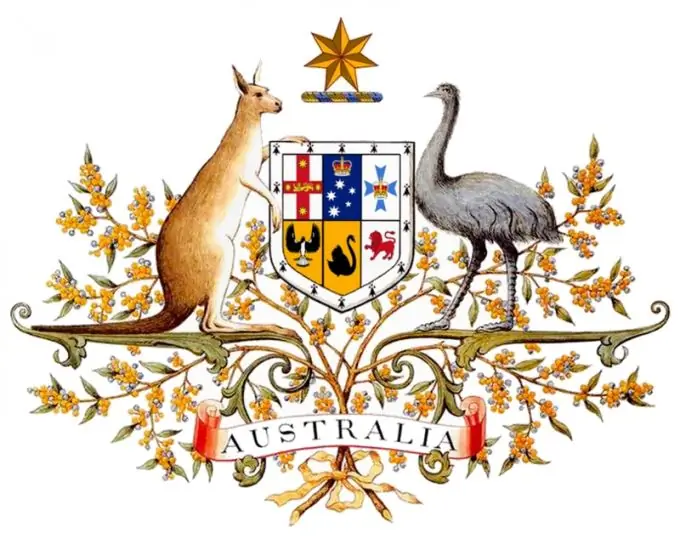- Author Antonio Harrison [email protected].
- Public 2023-12-16 07:44.
- Last modified 2025-01-22 21:44.
The Australian coat of arms bears little resemblance to the traditional heraldic signs of other states, because it depicts animals and plants. However, at the same time, it fits well into the heraldic system, because each of its details has a special meaning.

By the will of the king
Australia received its own coat of arms relatively recently, in 1908, at the behest of King Edward VII. Four years later, his successor, George V, approved the changes in the coat of arms, and so it has remained to this day.
In the center of the Australian coat of arms is a shield, which is divided into six parts. It symbolizes the six states of the country that were part of it in 1912: Tasmania, Victoria, Queensland, New South Wales, South and Western Australia. Each state is represented by a mini-image of its own coat of arms. Internal and external territories are reflected visually on it. The shield is surrounded by a silver border with fourteen black crosses. It is also considered as a stylized ermine ribbon - a sign that Australia is part of the British Commonwealth of Nations.
New South Wales on the coat of arms is a cross with a gold star, Victoria is the Southern Cross and Crown constellation, Queensland is the Maltese cross, South Australia is a shrike, Western Australia is a swan, Tasmania is a lion.
Above the shield is a blue and gold burette. Previously, it was only a part of the knight's headdress, which softened the blows to the helmet. Then it began to mean that the person had been on a crusade, and the burelet was included in the list of heraldic symbols. It is used as a status element.
Above the windbreak is the star of the Commonwealth. It has seven rays. Six of them symbolize the Australian states that joined the federation in 1901, and the seventh - all future territories. Initially, the seventh ray meant only the Territory of Papua, and its expanded meaning appeared in 1908.
Like no one else
The shield on the coat of arms is supported by kangaroo and emu figures. These animals were chosen not only because they are found only on the continent of Australia and have long become its symbols. One of their features is that they almost do not know how to move backwards, that is, to move backwards. So for Australians, emu and kangaroo are a symbol of progress and the motto "Australia is always going forward!"
At first, the animals were depicted not very much like the original, but in 1912 a more realistic drawing was approved.
Kangaroo and emu figures are located among the branches of golden acacia, or mimosa. The plant is recognized as the national symbol of the state. It can be found throughout most of Australia, and in September it even celebrates National Acacia Day. By the way, the plant is depicted on the coat of arms without botanical accuracy, and is generally not included in the official heraldic description of the coat of arms, as well as the inscription "Australia" on the ribbon woven into its branches.






